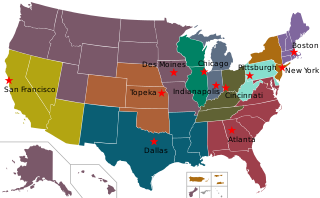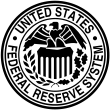
The Federal Reserve System is the central banking system of the United States of America. It was created on December 23, 1913, with the enactment of the Federal Reserve Act, after a series of financial panics led to the desire for central control of the monetary system in order to alleviate financial crises. Over the years, events such as the Great Depression in the 1930s and the Great Recession during the 2000s have led to the expansion of the roles and responsibilities of the Federal Reserve System.

The money market is a component of the economy which provides short-term funds. The money market deals in short-term loans, generally for a period of a year or less.

A repurchase agreement, also known as a repo, RP, or sale and repurchase agreement, is a form of short-term borrowing, mainly in government securities. The dealer sells the underlying security to investors and, by agreement between the two parties, buys them back shortly afterwards, usually the following day, at a slightly higher price.
An open market operation (OMO) is an activity by a central bank to give liquidity in its currency to a bank or a group of banks. The central bank can either buy or sell government bonds in the open market or, in what is now mostly the preferred solution, enter into a repo or secured lending transaction with a commercial bank: the central bank gives the money as a deposit for a defined period and synchronously takes an eligible asset as collateral.

The Federal Home Loan Banks are 11 U.S. government-sponsored banks that provide liquidity to the members of financial institutions to support housing finance and community investment.
The discount window is an instrument of monetary policy that allows eligible institutions to borrow money from the central bank, usually on a short-term basis, to meet temporary shortages of liquidity caused by internal or external disruptions. The term originated with the practice of sending a bank representative to a reserve bank teller window when a bank needed to borrow money.
A primary dealer is a firm that buys government securities directly from a government, with the intention of reselling them to others, thus acting as a market maker of government securities. The government may regulate the behaviour and number of its primary dealers and impose conditions of entry. Some governments sell their securities only to primary dealers; some sell them to others as well. Governments that use primary dealers include Australia, Belgium, Brazil, Canada, China, France, Hong Kong, India, Italy, Japan, Singapore, Spain, the United Kingdom, and the United States.

The Term Auction Facility (TAF) was a temporary program managed by the United States Federal Reserve designed to "address elevated pressures in short-term funding markets." Under the program the Fed auctions collateralized loans with terms of 28 and 84 days to depository institutions that are "in generally sound financial condition" and "are expected to remain so over the terms of TAF loans." Eligible collateral is the same as that accepted for discount window loans and includes a wide range of financial assets. The program was instituted in December 2007 in response to problems associated with the subprime mortgage crisis and was motivated by a desire to address a widening spread between interest rates on overnight and term interbank lending, indicating a retreat from risk-taking by banks. The action was in coordination with simultaneous and similar initiatives undertaken by the Bank of Canada, the Bank of England, the European Central Bank and the Swiss National Bank.

This is a list of historical rate actions by the United States Federal Open Market Committee (FOMC). The FOMC controls the supply of credit to banks and the sale of treasury securities. The Federal Open Market Committee meets every two months during the fiscal year. At scheduled meetings, the FOMC meets and makes any changes it sees as necessary, notably to the federal funds rate and the discount rate. The committee may also take actions with a less firm target, such as an increasing liquidity by the sale of a set amount of Treasury bonds, or affecting the price of currencies both foreign and domestic by selling dollar reserves. Jerome Powell is the current chairperson of the Federal Reserve and the FOMC.
On March 17, 2008, in response to the subprime mortgage crisis and the collapse of Bear Stearns, the Federal Reserve announced the creation of a new lending facility, the Primary Dealer Credit Facility (PDCF). Eligible borrowers include all financial institutions listed as primary dealers, and the term of the loan is a repurchase agreement, or "repo" loan, whereby the broker dealer sells a security in exchange for funds through the Fed's discount window. The security in question acts as collateral, and the Federal Reserve charges an interest rate equivalent to the Fed's primary credit rate. The facility was intended to improve the ability of broker dealers to access liquidity in the overnight loan market that banks use to meet their reserve requirements.
The U.S. central banking system, the Federal Reserve, in partnership with central banks around the world, took several steps to address the subprime mortgage crisis. Federal Reserve Chairman Ben Bernanke stated in early 2008: "Broadly, the Federal Reserve’s response has followed two tracks: efforts to support market liquidity and functioning and the pursuit of our macroeconomic objectives through monetary policy." A 2011 study by the Government Accountability Office found that "on numerous occasions in 2008 and 2009, the Federal Reserve Board invoked emergency authority under the Federal Reserve Act of 1913 to authorize new broad-based programs and financial assistance to individual institutions to stabilize financial markets. Loans outstanding for the emergency programs peaked at more than $1 trillion in late 2008."
The System Open Market Account (SOMA) is one of the monetary policy tools used by the United States' Federal Reserve System that contains assets acquired by open market operations (OMOs). It is managed by the Federal Reserve Bank of New York, which the Federal Open Market Committee (FOMC) designated to execute OMOs on behalf of the entire Federal Reserve System.
The Troubled Asset Relief Program (TARP) is a program of the United States government to purchase toxic assets and equity from financial institutions to strengthen its financial sector that was passed by Congress and signed into law by President George Bush. It was a component of the government's measures in 2009 to address the subprime mortgage crisis.
The interbank lending market is a market in which banks lend funds to one another for a specified term. Most interbank loans are for maturities of one week or less, the majority being over day. Such loans are made at the interbank rate. A sharp decline in transaction volume in this market was a major contributing factor to the collapse of several financial institutions during the financial crisis of 2007–2008.
Commercial Paper Funding Facility (CPFF) was a system created by the United States Federal Reserve Board during the financial crisis of 2007–08 to improve liquidity in the short-term funding markets. It was reauthorized in March 2020 in reaction to the financial impact of the COVID-19 pandemic, including the 2020 stock market crash. The CPFF ceased purchasing commercial paper on March 31, 2021.
The Term Asset-Backed Securities Loan Facility (TALF) is a program created by the U.S. Federal Reserve to spur consumer credit lending. The program was announced on November 25, 2008 and was to support the issuance of asset-backed securities (ABS) collateralized by student loans, auto loans, credit card loans, and loans guaranteed by the Small Business Administration (SBA). Under TALF, the Federal Reserve Bank of New York authorized up to $200 billion of loans on a non-recourse basis to holders of certain AAA-rated ABS backed by newly and recently originated consumer and small business loans. As TALF money did not originate from the U.S. Treasury, the program did not require congressional approval to disburse funds, but an act of Congress forced the Fed to reveal how it lent the money. The TALF began operation in March 2009 and was closed on June 30, 2010. TALF 2 was initiated in 2020 during the COVID-19 pandemic.
Commercial Paper Funding Facility (CPFF) was a system created by the United States Federal Reserve Board during the Global financial crisis of 2008 to improve liquidity in the short-term funding markets. The CPFF was created on 27 October 2008 and funded a special purpose vehicle (SPV) that purchased three-month unsecured and asset-backed commercial paper (CP) from eligible issuers. This resulted in greater availability of credit for firms doing business. It worked under the aegis of the Federal Reserve Bank of New York where the NY Fed finances the purchase of highly rated unsecured and asset-backed commercial paper from eligible issuers via eligible primary dealers. The facility expired February 1, 2010. The final CP purchased matured on April 26, 2010. All CP notes purchased were repaid in full.
On March 23, 2009, the United States Federal Deposit Insurance Corporation (FDIC), the Federal Reserve, and the United States Treasury Department announced the Public–Private Investment Program for Legacy Assets. The program is designed to provide liquidity for so-called "toxic assets" on the balance sheets of financial institutions. This program is one of the initiatives coming out of the implementation of the Troubled Asset Relief Program (TARP) as implemented by the U.S. Treasury under Secretary Timothy Geithner. The major stock market indexes in the United States rallied on the day of the announcement rising by over six percent with the shares of bank stocks leading the way. As of early June 2009, the program had not been implemented yet and was considered delayed. Yet, the Legacy Securities Program implemented by the Federal Reserve has begun by fall 2009 and the Legacy Loans Program is being tested by the FDIC. The proposed size of the program has been drastically reduced relative to its proposed size when it was rolled out.
United States policy responses to the late-2000s recession explores legislation, banking industry and market volatility within retirement plans.

On the morning of September 17, 2019, interest rates on overnight repurchase agreements, which are short-term loans between financial institutions, experienced a sudden and unexpected spike. A measure of the interest rate on overnight repos in the United States, the Secured Overnight Financing Rate (SOFR), increased from 2.43% on September 16 to 5.25% on September 17. During the trading day, interest rates reached as high as 10%. The activity also affected the interest rates on unsecured loans between financial institutions, measured by the Effective Federal Funds Rate (EFFR), which moved above its target range determined by the Federal Reserve.







